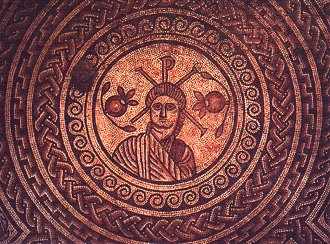
Roman Antiquities and Dark Star Symbolism
In any study that borders on 'the fringe' of what might be scientifically acceptable, the mainstay of rational debate hinges upon physical evidence. It would be nice to claim, as many do, that various snippets of astronomical data concretely provide a basis for the existence of Nibiru, or Planet X, in its most likely guise as a sub-brown dwarf. But the scientific evidence amassed to date remains only sufficient to raise expectations, not completely counter the doubts of sceptics who blunder into the fray, often unprepared for the growing persuasiveness of the evidence. Yet, when forced to face up to the potentials that lie beyond Neptune, they can always negate the pro-lobby by merely pointing out that since Planet X hasn't been found yet, it cannot exist. Until it is found, which I'm quite sure isn't far off, they hold the balance of power with that merest of assertions.

But
such a state of affairs does not hold sway when one considers evidence
from 2000 years ago. The tables are turned somewhat, because the
'Gospel truth' that is so dutifully ingrained in us from such an early
age has little physical evidence to back it up. Biblical scholarship
in the 20th Century onwards has been highly sceptical regarding claims
made by theologists (1), whose own efforts to substantiate the life of
Christ within recorded history often relied upon the minutest thread of
evidence, ballooned out of all proportion in order to preserve the Christian
tradition in the minds of the faithful (2). Jesus Christ may well
have walked the streets of Jerusalem, but it is certainly not clear that
any contemporary, non-Christian writers, like Josephus, were paying the
slightest attention.
We are also forced to rely upon the often mythologised testimony of the early Christian writers. And even now, as a Western culture, we continue to delude ourselves that the Gospels are largely accurate, finding that the problematic material can be side-stepped by faith.
We may be selectively ignoring the many other causal factors operating at that time; the melting pot of religious ideas vying for attention under the dominance of Rome. And while the publication of the Dead Sea Scrolls has helped to generate a lively, and often controversial debate about the origins of Christianity (3,4), might it also be useful to study Roman and Herodian antiquities at that time? Because the fact that so many religions and cults have their roots in astronomy doesn't seem to impact upon the established origins of Christianity whatsoever.
Perhaps it should, particularly given the unusual celestial symbolism employed in the Christian Nativity.
Various mythological aspects of Christianity share common ground with other ancient cults that evidently took the heavens very seriously indeed (5). Is it possible that there is a common astronomical origin that has been denied us by the headlong momentum to celebrate the divine life of Jesus Christ?

If that is the case then one fact should emerge. An astronomical event of revolutionary importance in the Middle East must surely have been recorded by the Romans. In my first book 'Winged Disc', I have argued that such evidence lies within the much-studied 'red Sirius' anomaly, and in particular the writings of Seneca (6). I have also reproduced Graeco-Roman motifs and stylised symbols that have common ground with older ones from Egypt and Mesopotamia, perhaps indicating a tradition that was re-invigorated during times of revolutionary activity in Palestine. A sign in the heavens, perhaps, that sparked the belief in the Return of a King, and a coming emancipation from the Romans.
In this essay I would like to offer further evidence to support the notion that the so-called 'Star' was real enough, and not merely an astrological portent as has been recently concluded by many (7,8). I contend that this Star did not appear as we have been led to believe by our Nativities, but as a fiery crescent with a stellar cluster of up to seven stars in attendance.
In reality, it may have been a rather faint apparition in the sky, simply causing a reddening in the perihelion constellations, with a barely discernable collection of 'new' stars in attendance. (The Reddening, or Rubedo, could be likened to the turning of the Celestial Waters into wine).
Despite the difficulties in observing the phenomenon, its mythological significance was such that a renaisance of religious thinking took place. Thus, the Messianic Star became a catalyst for change in Roman-occupied Palestine. And, vitally, its appearance was recorded on coins.
Crescent and Stars
The symbolism of the Crescent and 7 stars is not one widely recognised as meaningful in its own right. Yet it appears to permeate much religious iconography, either blatantly or in a stylised form. Because the crescent generally signifies the moon, it is not really difficult to see why. However, the Star or 7 stars often appear within the crescent itself on these symbols, or in a semi-circle around it. As I have discussed at great length on this web-site and in 'Winged Disc', that tends to preclude the moon as being responsible...clearly stars cannot appear 'within' the moon, and no constellation on the ecliptic takes on the form of a semi-circle. The symbol is not, therefore, a conjunction of the moon with, say, the Pleiades, or 7 sisters. Even if it were, this would hardly hold any actual significance for the ancients. It would certainly not be important enough to justify its appearance on magical amulets, 'Gnostic Gems' or coins, like this one from the time of emperor Hadrian (9):
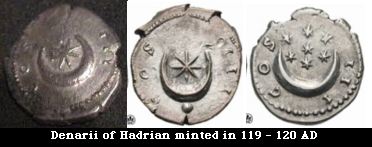
Several of these images were kindly sent to me by Robert Kern, who has been researching the possibility that Nibiru may have been the Messianic Star. He points out that Hadrian defeated the revolutionary Jewish leader Simon Bar Kochba, who led an unsuccessful insurrection against the Romans between 132-135AD. Bar Kochba was widely known as the 'son of a star', so Hadrian's glory in his defeat may be reflected in this coinage.
Which may give us an insight into the meaning
of the Star that Bar Kochba was being associated with. There is a
variation on a theme here, with the familiar Crescent and Star emblem (later
employed by the Muslim faith), but also seven stars within a crescent.
The close association of these symbols is very interesting indeed.
If it indicates an anomalous celestial phenomenon at some time prior to
the reign of Hadrian, then it is evidently not astrological in origin.
It is clearly the recording of an observed phenomenon that makes no sense
if the crescent is simply the moon...stars cannot appear 'within' the moon's
disc, after all.
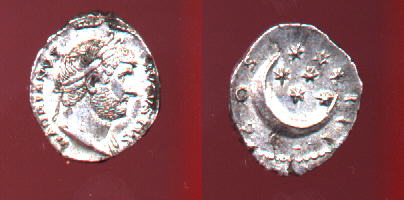
Because the generally accepted scenario regarding the Messianic Star links it with the triple conjunction in 7BC, researchers interested in providing an explanation for the Star of Bethlehem tend to ignore actual evidence of anomalous celestial phenomena around that time. Their minds are already made up. For instance, the fact that Sirius was often described as appearing red during that period seems to be brushed aside, although its symbolic importance to messianic myths is clear, as I have discussed in my book.
Sceptics arguing that the Messianic Star was astrological often point out that an anomalous celestial event would have been recorded by Chinese astronomers. David Hughes, for instance, has discussed possible candidates in the ancient Chinese literature at some length. While he seems able to rule out the obvious suspects, he does point out that the nomenclature used by the ancient Chinese astronomers is far from clear at times:
"Of the various comets and novae that appeared about the time of the birth of Jesus, comets with tails, the hui-sing or broom stars, seem to be self-evidently comets. The po-hsing are probably also comets which in this instance are viewed either head-on or end-on, though a small po comet was not easily distinguishable from a k'o-hsing, a guest of visiting star." (8)
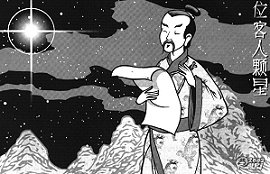
You could be forgiven by being a little confused by this. There seems to be a linguistic cross-over between novae and comets, muddying waters that are usually considered to be clear. It certainly does not tie in with the general notion that ancient Chinese astronomers were accurately recording all celestial events in a way that we can always directly translate. Furthermore, even the appearances of Halley's Comet were not systematically noted by the Chinese, references to it being 'probably recorded in China', and sometimes not at all (8). If Nibiru was actually rather faint, possibly being barely visible to the naked eye, then only those actually watching for it may have spotted it, and even then with the help of optical aids.
And if the Chinese had spotted such a strange celestial apparition, how would they have described it? Would we recognise the description for what it was, considering that we aren't actually expecting such an entry to appear? After all, no modern astronomers ever discuss a cluster of stars within fiery wings, so what would stop the translaters of ancient Chinese documents rendering such an entry as a 'broom star', or 'guest star', presuming it to be a comet or nova?
Herod's Judaism
One of the most intriguing finds made by Robert Kern is a Herodian coin apparently showing the same anomalous symbolism. There appears to be a central star accompanied by palms, thus forming a stylised winged disc. Below this is a soldier's helmet, creating a link between military power and the Star. One might expect such an overt display of rulership by Herod the Great, but is it possible that he was also keen to display his religious sentiments? This may not be quite as unlikely as it initially sounds.
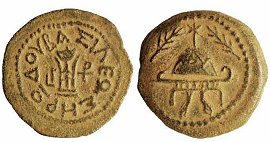
According to the maverick Australian scholar Barbara Thiering, Herod "converted to a version of Judaism that suited him, and proceeded to impose it on the world" (10). He set about raising vast sums of money by spreading his form of Judaism to Jews and Gentiles beyond the Holy Land, requiring from them in return a one-off payment. The sums he raised were used on various major projects, including the restoration of Jerusalem, fortifying the harbour at Caesarea and, significantly, completely rebuiding the Temple in Jerusalem.
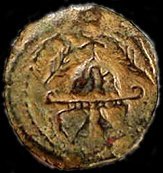
Herod commissioned the reconstruction of the Temple 'just before 21BC' (10). Its importance for Jews everywhere cannot be underestimated. Robert Kern wonders whether this momentous work reflected events in the heavens; that the rebuilding of the Temple was instigated by Herod because the Star had reappeared, and a new religious fervour had swept the Holy Land and Jewish Diaspora. Herod, as King of the Jews, was well placed to benefit from the return of the Celestial King, or Messianic Star. As I have shown in my recent essay 'Nibiru and the Dead Sea Scrolls', there is direct evidence from Qumran that the return of this Star was known of, and anticipated. Given that Herod's tutor was Menahem the Diaspora Essene (10), it seems highly likely that Herod was initiated into this ancient Nibiru mystery.
But even if Herod was simply the 'nominal head' of Menahem's mission to spread news of the New Israel, the construction of the Temple marks great events just before the birth of Christ. If Nibiru had returned, then these political and religious developments start to make a lot more sense.
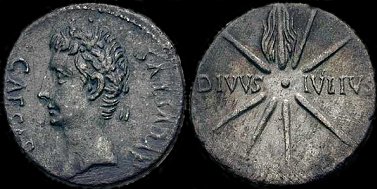
Around the same time that Herod began to rebuild the Temple in Jerusalem, some remarkable coinage was issued by the Roman Emperor Augustus (11). This silver Denarius coin was minted around 19BC and shows a comet with 8 rays, the eighth of which seems to be fiery, said to celebrate the 'Divine Julius' (12).
It is an odd depiction of a comet, emphasising a strong light source in the centre, rather than the cometary tail.
Although this may well symbolically allude to a previous comet seen during the time of Julius Caesar (in 44BC), its unusual characterisation may also hint at a rather extraordinary, contemporary phenomenon observed around the time the coin was minted.
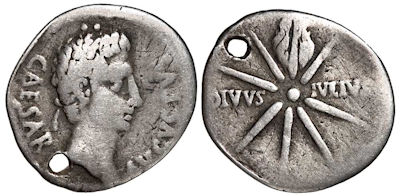
Augustus
is linked to 'omens from heaven' in this extract from Vergil:
"Lo! Caesar and
all the Julian Line, predestined to rise to the infinite spaces of heaven.
This, yea, this is the man, so often foretold you in promise, Caesar Augustus,
descended from God, who again shall a golden Age in Latium found,....Yea,
even now, at his coming, foreshadowed by omens from heaven, ....
( ) are mine." Vergil's Aeneid, Book VI.ii 789-800,
847-853
Were these two coins, both minted around 18-19BC, trying to depict a rather odd celestial apparition, that was neither strictly a comet, nor a star, but rather a fiery conflagration in the sky that defied a normal definition? Did Nibiru 'flare up' for a period of time as it approached the outer solar system? This is known to happen with brown dwarfs, although our knowledge of sub-brown dwarfs (as old and as cold as Nibiru must be) does not allow us to know for sure in this case.
Such an event could well be considered
as a formidable omen, one that justified the deification of the line of
Julian as 'Gods'. This would be particularly valid as an argument
if such a connection between deification of ruling kings and the appearance
of the 'Star' was a prophesied one. Which is precisely what the parallel
Messianic fever in Palestine was about. All of this could be understood
to stem from an ancient knowledge of the cyclical return of the Celestial
King, Nibiru, as argued by Zecharia Sitchin.
More Coins
Here are further examples of the crescent and seven stars imagery used on Roman coins.
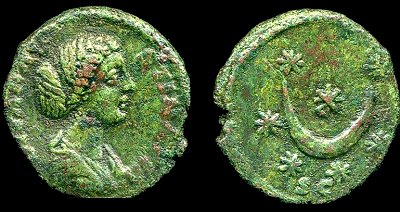
The first one is: Faustina, the wife of Hadrian's successor Antoninus Pius-AE AS. R: Crescent moon with seven stars/SC. RIC 1714
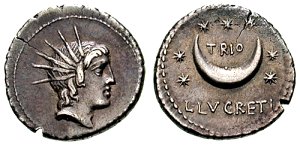
The second one is: Lucretius Trio Denarius. 76BC. Radiate head of Sol / TRIO within crescent moon with 7 stars.
Other Clues
During the 1st century AD a variety of coins were issued, by different ancient rulers, which bore a great resemblance to one another. This hints at the importance attached to the astronomical symbols used.
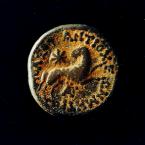
A star is seen next to the zodiacal sign of Aries, one of the final constellations of Nibiru's visible perihelion transit.
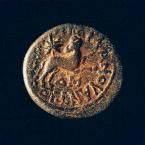
The Star's position with respect to 'the Ram' is in keeping with the descriptions I have given of Nibiru's orbital path in 'Winged Disc', and would mark the point of departure of the Dark Star and its moons...the Sacrifice of the Lamb, perhaps.
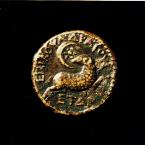
The last of these coins shows the now familiar Star and Crescent motif, said to symbolise 'majesty or sovereignty' (9). Christians may find this interesting in itself, given the link between 'sovereignty' and the Lamb on a coin from 55AD; really quite early in the history of the Christian church, which was certainly not officially recognised by any state at that time.
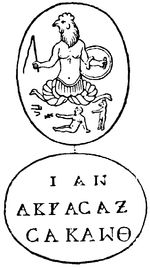
But it may also provide us with a marker along the route taken by Nibiru, the 'Celestial Lord' of the ancient Mesopotamians. If it does, then we may need to reassess the timing of Nibiru: its (barely) visible transition across the sky seems to have taken several decades between the time of the construction of the Temple in Jerusalem and the minting of the first of these coins. As we shall see, this may not be as unreasonable as it first sounds. These various coins compliment the plethora of 'Gnostic Gems', or magical amulets, that circulated widely during the Graeco-Roman period (12).
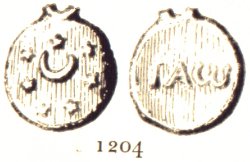
While many of these artifacts appear to have mundane origins (13), mostly as charms to ward off evil and disease, many contain anomalous celestial imagery accompanied by the Greek letters Iota Alpha Omega (IAO). As the roman coin above, this amulet shows a distinct crescent surrounded by a circle of seven stars. See darkstar1.co.uk/ds18.html for more examples.
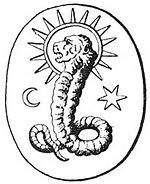
The Abraxas and Demiurge have particular cosmological significance for certain sects during the era in question. Another set of evolving symbols in the ancient Middle East were the Tree of Life and the Jewish Menorah (14).

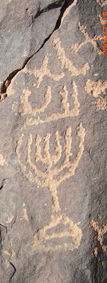
The Mesopotamian Tree of Life is often seen in conjunction with their gods, and the symbol of the Winged Disk. The later Jewish symbol of the seven-pronged Menorah seems to have evolved from its more eastern counterpart, perhaps providing a link between the ancient knowledge of Sumer and the gnostic symbolism deployed during the Graeco-Roman era.
The Timeline
To close, I would like to quickly explore the potential repercussions about the timing of Nibiru of this new material. During the last year or so I have been considering the question of how long Nibiru appears in the heavens. The writings of Zecharia Sitchin tend to suggest that Nibiru acts rather like a comet returning to the inner solar system, particularly the asteroid belt (15). The fact that this belt has not been 'cleared' by such a regular passage of a planetary body suggests otherwise, however. Given that the Earth's own orbit no longer takes in the asteroid belt, it seems reasonable to divest ourselves of the assumption that Nibiru returns to that spot. This opens things up tremendously.
There are those who would argue that previous Earthchanges point towards an Earth-crossing orbit, but I am minded towards an alternative scenario, one where Nibiru's perihelion passage occurs through the outer solar system. Together with a knowledgeable researcher who goes under the name 'Rajasun', I have considered the scientific evidence regarding the behaviour of the solar system, and how a small brown dwarf orbiting the Sun might fit in. While I want to expand upon this subject at much greater length in my next book, it seems fitting to make the following comment. If Nibiru passed through the outer planetary zone, or even just through the Edgeworth-Kuiper belt, then its appearance would be markedly dimmer than previously thought, and it would remain in the sky for a very long time indeed, probably years, possibly decades. In that sense, the Star may have been a celestial Messiah over the period of a lifetime. Its visual impact may have been be very subtle, and its lack of dynamic character would have lessened the probability of being noticed, unlike a comet for instance.
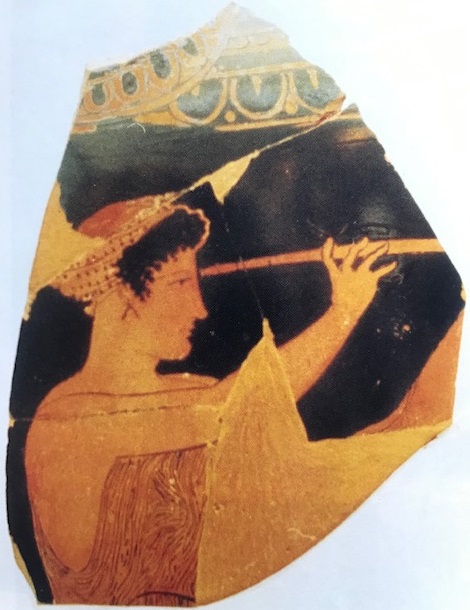
Image Credit: Robert Temple (Image 13)
This would very much be in keeping with the scenario painted by the 'red Sirius' anomaly, which I continue to believe supplies us with the best evidence for a Nibiru appearance in the Graeco-Roman period (see 'Winged Disc'). The astronomical effect may have been very subtle indeed, noticed only by expert astrologers and astronomers, although it's appearance spawned archetypal visions of apocalypse that greatly enhanced its mythic quality for a wider audience. If Nibiru, as a small brown dwarf arriving at the edge of the planetary zone, was barely detectable to the naked eye, yet was evidently seen, then how can we equate the two?
I believe that the scholarly researcher Robert Temple may have come up with a potential answer in his detailed study of ancient lenses (16). The ancients were able to scan the heavens with a rudimentary optical technology that enabled them to watch for Nibiru's re-appearance. Who finally discovered the Star of the East is anyone's guess. Possibly the Magi, possibly the latter-day Followers of Horus in Ptolemaic Egypt.
Whatever the answer, I am increasingly confident that the means were there to discover it, and then word quickly spread throughout the Roman lands in the East. As a result, the world would never be the same again.
© Andy Lloyd 9th May 2003
The Gorgon's Head
Last year, Theo Kermanidis showed me a film clip he had taken of a Roman artifact in Bath, Somerset. This frieze of a 'Gorgon's Head' is one of the relics found at the Roman Baths there, and is on general display at this popular tourist location in the West of England.
Theo disagreed with the accepted interpretation of this icon, which formed part of a pediment at the front of one of the Temples in Bath, understood to be dedicated to the goddess Sulis Minerva. The head is clearly male, however, which has puzzled experts down the years. It is thought to be a cross between this goddess and a Gorgon. Theo was struck by the image's solar characteristics, which looked similar to those of Mithras, a popular deity imported by the Romans from Persia in the centuries after Christ. He also noted the star located above the motif, again indicating that the head had an astronomical origin. Theo urged me to visit Bath to see it, which wasn't that unreasonable considering he'd travelled all the way from Australia while I only needed to drive 40 miles down the A46! But life being as it is it took me a full year to get round to it.
I was also struck by the solar characterisitics of this image. I'm not the only one. Walking around Bath I noticed several reproductions of this popular motif on advertising hoardings and the like, and they were invariably Sun-like. Yet the commentary from the Museum only mentioned the solar character in passing, prefering to allude to a more mythological and, to my mind, more far-fetched explanation.
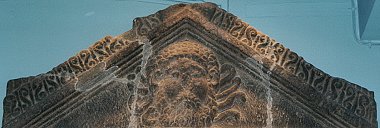
Compare the Bath 'Gorgon' with this example from Chester. The Chester Gorgon has snakes around its head that are far more characteristic of the mythological creature. The Chester example looks neither 'Solar' nor radiant.
As my family and I walked around among the other tourists, we came to a second pediment. This one was firmly dedicated to Luna. It was similar to the 'Gorgon's Head', but the goddess shown on the second Temple pediment was evidently the Moon. There was a crescent moon to prove it. There was no question about it this time.
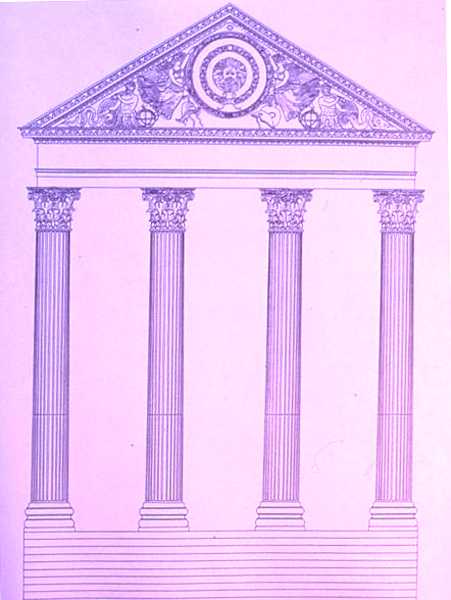
So if one pediment was devoted to a lunar deity, then it doesn't seem too improbable that the main Temple was Solar in nature. Why was this simple solution so adroitly ignored by the Curator of the Museum, and the academic consensus that had been forming over the last 200 years about the nature of this icon? I suspect it is because the frieze has other uncomfortable attributes connected with the head.
It is surrounded by two concentric and stylised circles, the inner of which is broken by a circular object. Above the frieze is an eight-pointed star. If the 'Gorgon's Head' symbolises the Sun then it looks awfully like the Romans were showing it as the centre of the solar system. Which, as we all know MUST be impossible. Because the ancients didn't have that kind of insight into the true nature of the cosmos, did they?
And then there's this star, perched above and beyond the 'orbits' around the Sun. Were the Romans trying to tell us something? The Romans did not live in isolation from the conquered people of ancient Britain, or of Gaul (where the pediment is thought to have been made). These indigenous peoples had a long history of building megalithic sites with accurate astronomical alignments. Their traditions were handed down through the Druidic line orally, over many generations.
Early during the occupation the Romans went out of their way to try and exterminate the entire Druid culture in Britain. Yet the Romans also integrated conquered mythologies and mystery cults into their own belief systems. Christianity is a good case in point!
Perhaps some of that local culture fed into the lives of the Roman land-owners of Western Britain, including a highly prized knowledge of the planets, the Sun and Moon. After all, Bath was recognised as a holy site for both the Romans and the conquered ancient Britons, and it is not many miles away from equally significant megalithic sites like Avebury and Stonehenge. The importance of the latter site for Lunar and Solar observation is well documented.
So what was the Star above the concentric circles around the Sun? (see the film clip above) Could it have been the Star of the ancients, Nibiru? Could the other images on the pediment give clues to its position in the constellations as it appeared in the Graeco-Roman period? It is an interesting possibility.
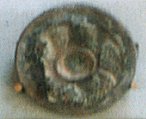
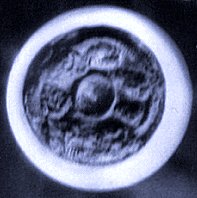
In the summer of 2005, my fami9ly and I visited Chedworth Roman villa, an archaeological site of a remarkable Roman building in the Cotswolds. This bronze broach had been discovered at the site, showing a central emblem surrounded by seven circles. Perhaps this is simply a flower, but it is interesting symbolism nevertheless, in keeping with the discussions above.
Written by Andy Lloyd, May 2003, and updated 2005
author of 'The Dark Star' (2005), 'Ezekiel One' (2009), 'The Followers of Horus' (2010) and 'Darker Stars' (2019)
References
1) Michael Baigent, Richard Leigh & Henry Lincoln "The Messianic Legacy" Jonathan Cape 1986
2) Carsten Peter Thiede & Matthew d'Ancona "The Jesus Papyrus" Weidenfeld & Nicholson 1996
3) Michael Baigent & Richard Leigh "The Dead Sea Scrolls Deception" Jonathan Cape 1991
![]() The Dead Sea Scrolls Deception
The Dead Sea Scrolls Deception
4) Philip Davies, George Brooke & Phillip Callaway "The Complete World of the Dead Sea Scrolls" Thames & Hudson 2002
![]() The Complete World of the Dead Sea Scrolls
The Complete World of the Dead Sea Scrolls
5) Timothy Freke & Peter Gandy "The Jesus Mysteries" Harper Collins 1999
6) A. Lloyd "Winged Disc: The Dark Star Theory" 2001
![]() The Dark Star: The Planet X Evidence
The Dark Star: The Planet X Evidence
7) P. A. H. Seymour "The Birth of Christ: Exploding the Myth" Virgin 1998
8) D. Hughes "The Star of Bethlehem Mystery" J. M Dent 1979
9) eclipse.net (article no longer available online) With thanks to Robert Kern
10) B Thiering "Jesus the Man: A New Interpretation from the Dead Sea Scrolls" Ch5, Doubleday 1992
11) "Augustus. 27 BC-14 AD. AR Denarius (3.67 gm). Struck 19-18 BC. Caesaraugusta mint. Head of Augustus left, wearing oak-wreath / DIVVS IVLIVS across field, comet of eight-rays. RSC 97" Thanks to Robert Kern
12) Erwin Goodenough 'Jewish Symbols in the Greco-Roman Period' Vol. III, published 1953 for Bollingen Foundation Inc by Pantheon Books of New York
![]() Jewish Symbols in the Greco-Roman Period
Jewish Symbols in the Greco-Roman Period
13) Campbell Bonner "Studies in Magical Amulets, Chiefly Graeco-Egyptian" Ann Arbor: University of Michigan Press, 1950
14) "Ancient and new Menorahs, Part 1: The oldest items"
menorah-bible.jimdofree.com_article
15) Zecharia Sitchin "The Twelfth Planet" Avon 1976
16) Robert Temple "The Crystal Sun: Rediscovering a Lost Technology of the Ancient World" Century 2000
Images
1. A face of Christ, c. 360AD, from Hinton St Mary, Dorset; now in the British Museum's Weston gallery of Roman Britain. Photograph: British Museum.
2. The Star and Crescent in the Muslim quarter of east Jerusalem. Photograph: Andre Durand
3 & 4. Denarii of Hadrian 119-120AD; thanks to Robert Kern
5. Illustration of the Chinese Astronomer is by Ralph Walters
6 & 7. Coins of Herod the Great "Herod the Great, 37 BCE, AE 8 prutah, 6.8 g, 7/8", O: Tripod (example right), ceremonial bowl (lebes) above, date LT (Year 3) and monogram TP in field 1 and "of King Herod" around in Greek R: Military helmet facing, wreath featuring acanthus leaf around, cheek pieces and straps, star above flanked by two palm branches" [my emphasis] With thanks to Robert Kern
(article no longer available online)
8. "Silver denarius issued by Emperor Augustus Caesar shows the comet of "Divine Julius" which was cleverly propagandized as a good portent"
eclipse.net (article no longer available online)
Robert Kern also points out interesting parallels with this account during the time of Augustus:
"The death of Agrippa, far from being merely a private loss to his own household (Augustus), was at any rate such a public loss to all the Romans that portents occurred on this occasion in such numbers as are wont to happen to them before the greatest calamities. Owls kept flitting about the city, and lightning struck the house on the Alban Mount where the consuls lodge during the sacred rites. The star called the comet hung for several days over the city and was finally dissolved into flashes resembling torches. Many buildings in the city were destroyed by fire, among them the hut of Romulus, which was set ablaze by crows which dropped upon it burning meat from some altar." [My emphasis] Cassius Dio — Book 54.htm Chapter 29
9. "Augustus, 27BC-AD14, AR Denarius (3.2g). Emperor head rt./Star in crescent, ca 18BC"
(article no longer available online) See RC219
10. "Kings of Mauretania. Juba II & Cleopatra Selene, 25 BC - 23 AD. AR Denarius (3.0g). Diademed head of Juba right; regnal title. Reverse: Lunar crescent, star above; queen's title" See Lot 4477 With thanks to Robert Kern
goldbergcoins.net catalogarchive
11 (a) "The
first bronze coins of Antioch depicting Aries were issued in ca. AD 5-11
which is close to when Quirinius was governor (AD 5-6) of Syria"
(b) "The last coin by the governor Silanus
showing Aries was issued in AD 13-14"
(c)
"Bronze coin of Quadratus issued in AD 55-56 showing Aries with a star
& crescent that symbolized majesty or sovereignty"
eclipse.net (article no longer available online) with thanks to Robert Kern
12. Image 1204, E. Goodenough 'Jewish Symbols in the Greco-Roman Period' Volume III, published 1953 for Bollingen Foundation Inc by Pantheon Books of New York
13. A 5th/4th century BC Greek pot excavated at the Shrine of the Nymph; in the Acropolis Museum at Athens: See 'The Crystal Sun' by Robert Temple. Photograph by Robert Temple
14. Images of the Gorgon's Head and Temple front & pediment from